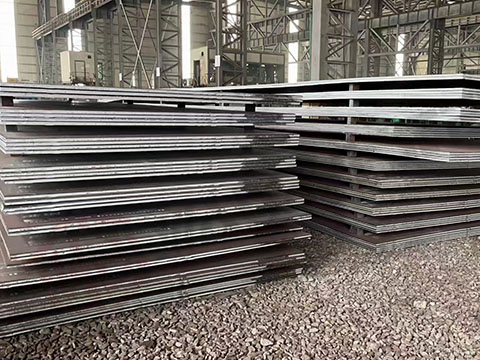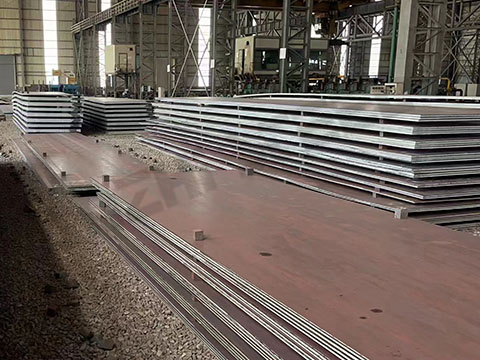Advantages and Disadvantages of Carbon Steel Plate
[edit] Uses of carbon steel plate
Carbon steel plate is one of the most commonly used steel materials. It can be found in many industries such as general manufacturing, light industry, construction, automobiles, transportation, energy, etc. It is easy to fabricate and relatively cheap in price, making it popular in many different countries.
[edit] Advantages of carbon steel plate
There are several advantages to choosing carbon steel plate over other forms of steel:
- Robust Construction: Carbon steel plate, has a higher concentration of carbon than other types of steel, generally between 0.02%-2.11%, which can solidify the metal’s interior structure and enhance its strength. As the percentage of carbon gets larger, the steel will become harder.
- Good Mechanical Properties: Carbon plate can be cut, welded, or processed easily due to its good abrasion resistance and machinability. While carbon steel can still stress and break under pressure, it’s less likely than with other types of steel.
- Various Specifications: Carbon steel plate is available in a wide selection of thicknesses, sizes, grades, and types.
- Wide Applications: This material can be used in many applications, from small household items to structural frames, wires, automobile components, surgical instruments, bolts, stampings, cranks, gears, bars, spring steel, railway tracks, cookware, pipelines, fencing, nails, etc.
- Affordability: It is cheaper than galvanised steel, galvalume steel, aluminium, or stainless steel, making it a popular metal used by many manufacturing companies.
= 
Disadvantages of carbon steel plate =
There are some disadvantages of carbon steel plate:
- The increase in carbon content has two effects: increasing strength and decreasing plasticity of steel. Therefore, high carbon steel plates can be difficult to work with. It can’t be easily bent or molded into different shapes, thus limiting its utility in certain applications.
- Corrosion protection performance is not good. Carbon steel is more susceptible to rust and corrosion when exposed to moisture and oxygen. This is because it has no protective coating on its surface. Carbon steel products can be galvanised for higher corrosion resistance. In view of this, some manufacturers use it as substrate for galvanised and galvalume steel products.
[edit] Related articles on Designing Buildings
- Aluminium.
- Cast iron.
- Concrete-steel composite structures.
- Galvanised steel.
- Major cast metal components.
- Metal fabrication.
- Metal roofing.
- Rust.
- Stainless steel.
- Stainless steel vs. galvanised steel.
- Structural steelwork.
- Super-strength steel structures.
- Types of metal.
- Types of steel.
- Weathering steel.
Featured articles and news
Latest Build UK Building Safety Regime explainer published
Key elements in one short, now updated document.
UKGBC launch the UK Climate Resilience Roadmap
First guidance of its kind on direct climate impacts for the built environment and how it can adapt.
CLC Health, Safety and Wellbeing Strategy 2025
Launched by the Minister for Industry to look at fatalities on site, improving mental health and other issues.
One of the most impressive Victorian architects. Book review.
Common Assessment Standard now with building safety
New CAS update now includes mandatory building safety questions.
RTPI leader to become new CIOB Chief Executive Officer
Dr Victoria Hills MRTPI, FICE to take over after Caroline Gumble’s departure.
Social and affordable housing, a long term plan for delivery
The “Delivering a Decade of Renewal for Social and Affordable Housing” strategy sets out future path.
A change to adoptive architecture
Effects of global weather warming on architectural detailing, material choice and human interaction.
The proposed publicly owned and backed subsidiary of Homes England, to facilitate new homes.
How big is the problem and what can we do to mitigate the effects?
Overheating guidance and tools for building designers
A number of cool guides to help with the heat.
The UK's Modern Industrial Strategy: A 10 year plan
Previous consultation criticism, current key elements and general support with some persisting reservations.
Building Safety Regulator reforms
New roles, new staff and a new fast track service pave the way for a single construction regulator.
Architectural Technologist CPDs and Communications
CIAT CPD… and how you can do it!
Cooling centres and cool spaces
Managing extreme heat in cities by directing the public to places for heat stress relief and water sources.
Winter gardens: A brief history and warm variations
Extending the season with glass in different forms and terms.
Restoring Great Yarmouth's Winter Gardens
Transforming one of the least sustainable constructions imaginable.























